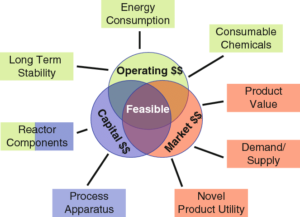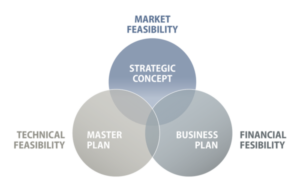Feasibility, technical and financial studies

These reports are in fact the most superficial and simplest form of feasibility reports that, according to the sensitivities of investors and banks, may be presented separately to more detailed sections, but their nature is not beyond these three:
۱- Introducing technical plans and studies
۲- Market studies
۳- Financial and economic studies
The feasibility study is a type of research method, especially in engineering and industrial management, which includes the following:
۱- The process of controlling and recognizing issues
۲- Identifying goals · Opportunities and threats
۳- Description of situations
۴- Identification of incomes
۵- Identifying costs
۶- Profit identification
۷- In the whole analysis of a project

What are the parts of a feasibility study:
Part 1: Familiarity with the plan and the company
Part II: Economic Survey (Market Studies)
Part 3: Technical studies and estimation of infrastructure facilities of the project
Section 4: Project Investment Estimation
Section 5: Estimation of production costs and annual sales value of the project
Section 6: Financial forecasting and how to finance the project
Section 7: Determining the financial and economic indicators of the project
What are Final Feasibility Studies (FS)?
The final feasibility study is performed after the design stage and the definition of its general framework in terms of product specifications, production capacity, and investment. These studies can be entered at different levels of project details according to the needs and requests of the client. In these studies appropriate to the dimensions of the project, the following are mainly considered:
۱- Determining the design site
• Determine the options of the project site in the selected location for the project
• Compare and prioritize different construction site options and prepare a site selection report
۲- Basic engineering studies and initial design
• Review and complete information and preliminary data related to atmospheric, geological, and hydrological conditions of the site, available infrastructure facilities for the project including water resources, energy resources, manpower resources
• Transportation systems, sources of raw materials, raw materials and supplies
• Basic engineering studies and raw material and process design
• Location and arrangement of units, systems, and design equipment
• Basic engineering design including process engineering, preliminary design of mechanical systems and equipment, preliminary design of plumbing, preliminary design of construction and infrastructure works, preliminary design of electrical systems and equipment, preliminary design of control systems and instrumentation
• Prepare a list of major items of all units, systems, and various parts of the plan, including a list of materials and their quantities, equipment, and machinery, and tools used in the work.
۳- Determining the executive policy of the plan
• Determining options for splitting the project into independent projects with specific commonalities
• Determine division of labor options between consultants, builders, and contractors
• Prioritize executive options according to available executable capabilities, project schedule, and project costs
۴- Preparation of project schedule for projects and services for engineering, procurement, logistics support, quality control, construction (including construction and installation operations), finance, equipping manpower for the period of operation, and commissioning
۵- Estimation of foreign exchange and Rial investment costs of the project separately for projects
۶- Preparing and presenting the report of the final feasibility stage
Purpose and Impartiality The feasibility study assesses the potential for success of a project, so neutrality is an important factor in the credit given by investors and lending institutions. Targeted and used an unbiased approach to provide the information on which decisions are made. The feasibility study must be experienced to be able to accurately estimate cost, time, people needed, and boundaries. Five Common Factors in Feasibility Study The term TELOS stands for five contexts in feasibility, including:
Technical
Economic
Legal
Operational
Scheduling

Feasibility study of technology and system This evaluation is based on the general design of system requirements and to determine that the company has the necessary technical expertise to complete the project. The following should be considered when writing a feasibility report:
• A brief description of the business to evaluate the more likely factors that may influence the study
• The part of the business that is being examined
• Human and economic factors
• Possible solutions to problems
• At this level, our concern is whether the proposal is technically and legally feasible at a reasonable cost
Legal feasibility determines whether the proposed system does not conflict with legal requirements, for example, a data processing system must comply with local data protection laws.
Operational feasibility is a measure of how a proposed system solves problems, takes advantage of the opportunities identified in the scope definition, and how well it meets the requirements identified in the analysis phase of the system development requirements. he does. The operational feasibility assessment focuses on the appropriateness of the proposed development projects for the existing business environment and objectives, given the development of the timing, delivery date, collaboration culture, and existing business processes.
Economic feasibility The purpose of examining economic feasibility is to determine the positive economic benefits for the organization for which the proposed system is provided, and includes measuring and identifying all expected benefits. This assessment usually has a cost/benefit analysis. Becomes.
Technical feasibility The technical feasibility assessment focuses on gaining an understanding of the technical resources available in the organization and the possibility of using them when needed in the proposed system, and an assessment of the available hardware and software and this To what extent they are compatible with the proposed system.
Schedule feasibility If a project is completed too long, it may fail before it is useful. This usually means estimating how long it takes to develop a system and whether It can be completed in a period of time and using some methods such as return period. The feasibility study is a measure of how logical a project’s timing is. Given the technical capability available, are project deadlines reasonable? Some projects start with specific deadlines, and you need to determine if these deadlines are. Are mandatory or are only desirable times.
Feasibility steps
First) reviewing the demand, determining the scope or scope of the project, recognizing the existing system, identifying needs and problems.
Second) Review and analysis of the goals of the new system. They are usually classified according to executive priority. Therefore, for each purpose, individuals and stakeholders are identified.
Third) Determining external entities in direct connection with the system. In this step, you must specify the text diagram that is an indicator of the system performance area.
Fourth) Determining the limiting factors of project implementation. In other words, the amount of risk in the success of the project is determined.
Fifth) Determining the exact scope of the project. Identify the needs and approve them for the customer.
Sixth) provide a Solution.
Seventh) Economic review of the project. Hardware, software, people, place, and time costs.
Feasibility report
The text of this report should address the following:
• Potential facilities of the organization
• Risks, hazards and their probability
• Priorities in the organization
• Scope of application
• Trade-economic aspects
• Areas of competition
• The importance of the project or production to the organization
• Necessary initial measures
• Proposed plan for implementation
• Necessary actions during the work
• Necessary manpower
• Necessary facilities and equipment
• Project or product life cycle
• Schedule implementation according to priorities
• Execution cost
September 23, 2019 No Comments